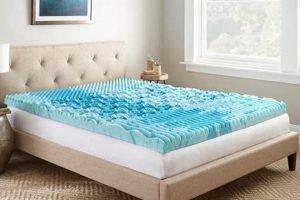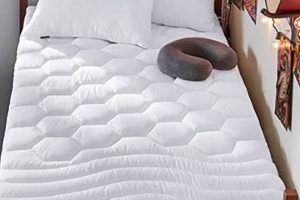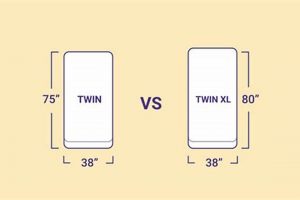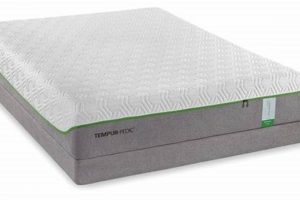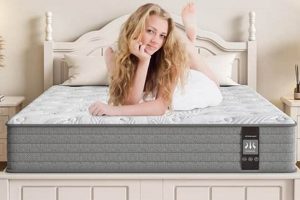An extended version of a standard full-size bed, this mattress offers additional length to accommodate taller individuals. Typically, a standard full mattress measures 54 inches wide by 75 inches long. The extended variation maintains the 54-inch width but increases the length to approximately 80 inches. This extra length provides more legroom and overall sleeping space for those who find the standard full size too short.
The primary benefit of this mattress size is enhanced comfort for taller sleepers. The added inches prevent feet from hanging off the edge, promoting better spinal alignment and potentially reducing pressure points. This can lead to improved sleep quality and reduced discomfort. Historically, mattress sizes have evolved to cater to varying body types and comfort preferences, with extended lengths emerging to address the needs of taller individuals who previously had limited options.
The following sections will delve into the specific considerations for selecting this mattress size, including factors such as room size, bed frame compatibility, and the available range of material and construction options. Further, this analysis will explore typical price points and retailers that offer this particular mattress dimension.
Selecting the Right Extended Full-Size Mattress
The subsequent guidelines are intended to assist in the selection of an appropriate extended full-size mattress. Careful consideration of these factors can optimize comfort and ensure the longevity of the investment.
Tip 1: Measure Available Space: Accurately measure the dimensions of the intended bedroom space. Ensure sufficient clearance around the bed to facilitate movement and avoid overcrowding the room. A too-large mattress will impact room functionality.
Tip 2: Evaluate Frame Compatibility: Verify compatibility with existing or intended bed frames. Standard full-size frames will not accommodate the added length. A frame specifically designed for an extended full, also known as a Full XL, is necessary to provide proper support and prevent mattress damage.
Tip 3: Consider Sleeper Height: Assess the height of the primary user. An extended full is generally recommended for individuals taller than approximately 5’9″ to prevent discomfort associated with inadequate legroom.
Tip 4: Assess Support Requirements: Evaluate individual support preferences. Consider the availability of innerspring, memory foam, latex, and hybrid constructions. Each material offers varying degrees of firmness and contouring, impacting spinal alignment and pressure relief.
Tip 5: Research Retailers and Brands: Conduct thorough research to identify reputable retailers and brands that offer extended full-size mattresses. Compare product specifications, warranties, and customer reviews to make an informed decision.
Tip 6: Inspect Edge Support: Evaluate the quality of edge support. Robust edge support prevents sagging and maximizes the usable sleep surface, particularly beneficial for couples sharing the mattress.
Adherence to these tips will improve the likelihood of selecting a mattress that adequately addresses individual needs and preferences, resulting in enhanced sleep quality and overall satisfaction.
The following section will provide a comprehensive overview of the various materials and construction techniques employed in extended full-size mattresses, offering further insight into selecting the ideal product.
1. Dimensions
The dimensions of a full mattress XL are fundamentally defining characteristics. The standard full mattress measures 54 inches in width and 75 inches in length. The “XL” designation signifies an extension of the length, typically to 80 inches. This dimensional difference is not merely a trivial variation; it directly impacts the suitability of the mattress for specific individuals, primarily those of greater height. The additional five inches of length provides crucial legroom, preventing discomfort and promoting proper spinal alignment. Without this dimensional alteration, taller individuals are relegated to either enduring cramped sleeping conditions or selecting a significantly larger mattress size, potentially impacting bedroom space.
The importance of precise dimensions extends beyond individual comfort to practical considerations such as bed frame compatibility. A full mattress XL requires a bed frame specifically designed for these dimensions. Attempting to use a standard full-size frame will result in inadequate support, potentially leading to premature mattress wear or even structural damage. Conversely, using a queen-size frame would leave unsupported gaps, creating an unstable and uncomfortable sleeping surface. Therefore, understanding and adhering to the specified dimensions is critical for ensuring the longevity and optimal performance of the mattress and its supporting structure. A real-world example is a customer purchasing a full XL mattress and attempting to use their existing full-size bed frame, only to discover the mattress overhangs, leading to instability and requiring a new frame purchase.
In summary, dimensions are an inseparable aspect of the full mattress XL. The 54″ x 80″ measurement dictates its suitability for specific users and its compatibility with appropriate bed frames. Disregarding these dimensions leads to compromised comfort, reduced mattress lifespan, and potential structural issues. Recognizing the significance of these measurements is essential for making an informed purchase and achieving optimal sleep quality. The challenge lies in ensuring consumers are fully aware of these dimensional nuances to avoid costly mistakes and prioritize long-term satisfaction.
2. Height Accommodation
Height accommodation is a primary consideration when evaluating the suitability of a full mattress XL. The extended length of this mattress configuration is specifically designed to address the needs of taller individuals, optimizing comfort and promoting proper sleep posture. The relationship between sleeper height and mattress dimensions directly impacts spinal alignment and overall sleep quality.
- Legroom Provision
Insufficient legroom forces taller individuals to sleep in a curled or fetal position, leading to restricted circulation, muscle cramping, and compromised spinal alignment. The extended length of the full mattress XL mitigates this issue by providing adequate space for full extension, allowing for a more natural and comfortable sleeping posture. The additional length directly prevents feet from hanging off the edge of the mattress, a common complaint among taller sleepers. This seemingly small dimensional change significantly enhances sleep quality by reducing discomfort and promoting better circulation.
- Spinal Alignment Support
Proper spinal alignment is crucial for minimizing back pain and promoting restorative sleep. A mattress that is too short can disrupt this alignment, leading to increased pressure on the lower back and neck. The full mattress XL facilitates proper spinal alignment for taller individuals by providing full body support from head to toe. This ensures that the spine remains in a neutral position, reducing the risk of discomfort and promoting healthy sleep patterns. A practical example is an individual experiencing chronic back pain due to sleeping on a standard full mattress finding significant relief upon switching to a full mattress XL.
- Edge Support Implications
While height accommodation primarily relates to the length of the mattress, it indirectly affects the importance of edge support. When a taller individual utilizes the full surface area of the mattress, including the edges, robust edge support becomes critical. Weak edge support can lead to mattress sagging and reduced usable sleep surface, negating some of the benefits of the extended length. Therefore, mattresses designed for height accommodation should prioritize reinforced edge support to maximize comfort and prevent premature wear. An example is a taller individual consistently sleeping near the edge of the mattress and noticing significant sagging over time if the edge support is inadequate.
- Partner Considerations
Even if one partner is not particularly tall, the added length of a full mattress XL can still be beneficial in shared sleeping arrangements. It provides additional space for both individuals to stretch out and move during the night without disturbing each other. This increased personal space can improve sleep quality for both partners, reducing instances of accidental contact and promoting more restful sleep. The additional space afforded by the XL dimensions can lead to more comfortable co-sleeping arrangements, especially for those who tend to move frequently during sleep.
In conclusion, height accommodation is a paramount factor in determining the suitability of a full mattress XL. The added length directly addresses the needs of taller individuals by providing ample legroom, promoting proper spinal alignment, and enhancing overall sleep comfort. The effectiveness of this height accommodation is further enhanced by considering edge support and partner considerations. Understanding these interconnected factors is crucial for making an informed decision and selecting a mattress that optimizes sleep quality and addresses individual needs.
3. Frame Compatibility
Frame compatibility represents a critical consideration when selecting a full mattress XL. This aspect dictates the support and stability afforded to the mattress, directly impacting its longevity and the overall comfort experienced by the sleeper. Incompatibility between the mattress and the frame can lead to structural issues and diminished sleep quality.
- Dimensional Concordance
The dimensions of a full mattress XL 54 inches wide by 80 inches long necessitate a bed frame specifically designed to accommodate these measurements. Standard full-size frames, typically designed for a 75-inch length, will not provide adequate support, leading to mattress overhang and potential damage. The frame must precisely match the mattress dimensions to ensure even weight distribution and prevent premature wear. A scenario involves a customer purchasing a full mattress XL and attempting to use an existing full-size frame, resulting in mattress sagging and voiding any warranty coverage.
- Support System Integration
The bed frame’s support system, including slats or a solid platform, must be adequately robust to handle the weight and dimensions of the full mattress XL. Insufficient support can cause the mattress to sag or compress unevenly, leading to discomfort and potentially exacerbating back pain. The spacing of slats, for instance, should be close enough to prevent mattress deformation over time. A real-world example is using a frame with widely spaced slats, causing the mattress to develop indentations and compromising its structural integrity.
- Headboard and Footboard Considerations
While not directly related to support, the headboard and footboard of the bed frame must also be compatible with the length and thickness of the full mattress XL. A headboard that is too low or a footboard that is too short may detract from the aesthetic appeal and potentially interfere with sleep comfort. Furthermore, the attachment mechanisms of the headboard and footboard must be sturdy enough to withstand the weight and movement of the mattress and occupants. Imagine a scenario where the headboard is not properly secured, leading to instability and noise during sleep.
- Platform Bed Alternatives
Platform beds offer an alternative to traditional bed frames, providing direct support for the full mattress XL without the need for box springs or slats. These platforms often feature a solid surface or closely spaced slats, ensuring even weight distribution and preventing mattress sagging. Platform beds must still adhere to the correct dimensional specifications to ensure proper fit and support. Consider a customer choosing a platform bed to eliminate the need for a box spring, only to discover that the platform is slightly smaller than the mattress, leading to an uneven sleeping surface.
Ultimately, frame compatibility is not merely a cosmetic concern but a fundamental requirement for ensuring the longevity and optimal performance of the full mattress XL. Adhering to the correct dimensional specifications, selecting a robust support system, and considering headboard and footboard compatibility are crucial steps in maximizing sleep comfort and safeguarding the investment in the mattress. These facets collectively contribute to a stable and supportive sleep environment, enhancing overall sleep quality and promoting long-term mattress durability.
4. Material Options
The material composition of a full mattress XL significantly influences its comfort, durability, and overall suitability for individual sleepers. The selection of materials impacts factors such as support, temperature regulation, and pressure relief, necessitating careful consideration of available options.
- Foam Density and Type
Varying foam densities, including memory foam, polyfoam, and latex foam, offer differing levels of support and contouring. Higher-density foams generally provide greater support and durability, while lower-density foams offer enhanced pressure relief. For example, a high-density memory foam layer can provide superior support for the spine, reducing back pain. Conversely, a low-density polyfoam layer may offer a softer sleeping surface. The choice of foam type directly affects the overall feel and support characteristics of the mattress, impacting sleep quality.
- Innerspring Coil Systems
Innerspring coil systems, commonly found in hybrid mattresses, provide support and bounce. The gauge and configuration of the coils influence the firmness and motion isolation of the mattress. Thicker-gauge coils offer greater support, while individually wrapped coils minimize motion transfer. For instance, a full mattress XL with a high-gauge innerspring system may be ideal for individuals seeking firm support. Material fatigue of these coils over time influences lifespan. Incompatibility of coil-type with sleeper is also considered
- Cover Fabric and Breathability
The cover fabric of a full mattress XL influences breathability and temperature regulation. Materials such as cotton, bamboo, and Tencel offer enhanced breathability compared to synthetic fabrics. A breathable cover fabric helps dissipate heat and moisture, promoting a cooler and more comfortable sleeping environment. For example, a full mattress XL with a Tencel cover may be beneficial for individuals who tend to sleep hot. This property, in particular, allows users greater sleep efficiency
- Construction and Layering
The layering and construction of a full mattress XL contribute to its overall performance. Multiple layers of different materials can be combined to achieve specific comfort and support characteristics. For instance, a full mattress XL may feature a combination of memory foam, latex foam, and innerspring coils to provide both pressure relief and support. The arrangement and thickness of these layers directly influence the overall feel and performance of the mattress. In a practical scenario, a well-constructed multi-layer mattress will provide more even weight distribution and support, enhancing sleep quality.
These material options offer a range of performance characteristics that influence the suitability of a full mattress XL for individual sleepers. Careful consideration of these factors is essential for selecting a mattress that provides optimal comfort, support, and temperature regulation. Disregarding these material properties leads to a compromised sleep experience. The challenge involves matching material properties to sleeper requirements.
5. Support System
The support system within a full mattress XL constitutes a foundational element directly influencing its performance and suitability. This system, whether composed of innerspring coils, foam cores, or a hybrid of both, bears the responsibility of providing adequate spinal alignment and distributing body weight evenly across the sleeping surface. A deficiency in the support system undermines the benefits of the extended length, potentially leading to discomfort and exacerbating musculoskeletal issues. For instance, an innerspring system with insufficient coil density can result in sagging, particularly under concentrated weight, negating the intended comfort for taller individuals who require consistent support along the entire mattress length. The connection is causative; a robust support system causes proper spinal alignment, and a deficient system causes discomfort and potential health issues. Its importance is found in the sleep quality afforded to the user.
Real-world examples demonstrate the practical significance of understanding the support system’s role. A taller individual, approximately 6’2″, experiencing chronic back pain on a standard full mattress may find relief upon transitioning to a full mattress XL featuring a high-density memory foam core. This is because the foam core conforms to the body’s contours, providing targeted support and alleviating pressure points. Conversely, an individual using a full mattress XL with a low-density foam core may experience sinking and a lack of support, regardless of the mattress’s extended length. The choice of support system, therefore, must align with individual needs and preferences to achieve optimal comfort and spinal alignment. A customer buying a bed online with a “full XL” dimensions, but failing to scrutinize the core support system, may find that it delivers limited support. Hybrid systems can combine the support and bounce for a more robust long-lasting and ergonomically sound option.
In summary, the support system is integral to the functionality of a full mattress XL. A well-designed support system ensures proper spinal alignment, distributes weight evenly, and enhances overall sleep comfort. The challenge lies in selecting a support system that caters to individual needs and preferences, considering factors such as body weight, sleeping position, and support requirements. Disregarding this critical aspect results in compromised sleep quality, accelerated mattress wear, and potential musculoskeletal issues. Selecting the correct dimensions of mattress without accounting for the support system, leaves the user unsatisfied and, ultimately, unfulfilled.
6. Price Range
The price range associated with a full mattress XL exhibits considerable variance, influenced by material composition, brand reputation, construction techniques, and retail location. A direct relationship exists between the quality of materials utilized and the resulting price point; mattresses incorporating high-density memory foam, natural latex, or sophisticated innerspring systems command a higher price compared to those constructed with lower-grade materials like basic polyfoam or open-coil springs. Brand recognition also plays a significant role, with established mattress manufacturers often pricing their products at a premium due to perceived quality and warranty assurances. The complexity of the mattress construction, involving multiple layers and specialized features such as reinforced edge support or cooling technologies, further contributes to the overall cost. An example is a full mattress XL constructed with CertiPUR-US certified memory foam and individually wrapped coils from a well-known brand retailing for significantly more than a similar-sized mattress with generic foam and a basic coil system. This has an immense impact on the market
Geographic location and retail markup significantly impact the final price accessible to consumers. Brick-and-mortar stores, owing to overhead costs and sales commissions, may offer the same mattress at a higher price compared to online retailers operating with lower operational expenses. Sales events, seasonal promotions, and clearance discounts can provide opportunities to acquire a full mattress XL at a reduced price, but it’s critical to compare product specifications and warranty terms across different retailers to ensure genuine value. For example, an online retailer may offer a full mattress XL at a discounted price, but the consumer must carefully review the shipping costs and return policies, which can offset the initial savings. Conversely, a local store may offer a higher price, but provides the opportunity to test the mattress before purchase and negotiate for additional discounts or services, such as free delivery and setup. The final result should equate to a price that is agreed between the provider and the customer.
In summation, the price range of a full mattress XL is a complex interplay of material quality, brand influence, construction complexity, and retail dynamics. Navigating this landscape requires diligent research, comparison shopping, and a clear understanding of individual needs and preferences. The challenge lies in balancing budgetary constraints with the desire for optimal comfort, durability, and long-term value. Prioritizing material quality, carefully evaluating warranty terms, and comparing prices across diverse retailers are crucial steps in making an informed purchase and securing a full mattress XL that aligns with both financial considerations and sleep quality requirements.
Frequently Asked Questions About Full Mattress XL
The following questions address common inquiries regarding the Full Mattress XL, providing clarity and concise information on its attributes and applications.
Question 1: Is a Full Mattress XL simply a longer version of a standard Full Mattress?
Affirmative. A Full Mattress XL maintains the standard Full Mattress width of 54 inches but extends the length from 75 inches to 80 inches, providing additional legroom.
Question 2: Who benefits most from a Full Mattress XL?
Individuals exceeding 5’9″ in height typically derive the greatest benefit, as the added length prevents feet from hanging off the edge, promoting better spinal alignment.
Question 3: Will a standard Full-size bed frame accommodate a Full Mattress XL?
Negative. A Full Mattress XL requires a bed frame specifically designed for its dimensions. A standard Full-size frame will be insufficient, potentially causing damage to the mattress.
Question 4: Are Full Mattress XL options available in various material types?
Yes. Full Mattress XL sizes are manufactured in various materials, including innerspring, memory foam, latex, and hybrid constructions, to cater to different support and comfort preferences.
Question 5: Does the extended length of a Full Mattress XL necessitate higher prices?
Typically, yes. The additional material and specialized manufacturing processes can lead to a marginal increase in price compared to standard Full-size mattresses of comparable quality.
Question 6: Where can Full Mattress XL sizes be purchased?
Full Mattress XL sizes are available through select retailers, both online and in brick-and-mortar stores. Availability may be less widespread compared to standard mattress sizes, requiring focused searches.
These FAQs illuminate critical considerations for those contemplating a Full Mattress XL, facilitating more informed purchasing decisions.
The subsequent section will present a comparative analysis, contrasting the Full Mattress XL with other mattress sizes to further assist in the selection process.
Conclusion
This analysis has dissected the characteristics, benefits, and considerations surrounding the full mattress XL. Dimensions, height accommodation, frame compatibility, material options, support systems, and price ranges have all been identified as crucial factors influencing its selection. The extended length, designed to accommodate taller individuals, necessitates careful attention to frame compatibility and support system capabilities.
The full mattress XL represents a specific solution for a defined segment of the population. Potential purchasers are strongly encouraged to assess individual needs, compare available options, and prioritize material quality and frame compatibility to ensure optimal sleep quality and long-term satisfaction. Failure to thoroughly evaluate these factors can lead to a compromised sleep experience and a diminished return on investment. The ultimate decision should reflect a calculated assessment of both comfort requirements and practical constraints.


